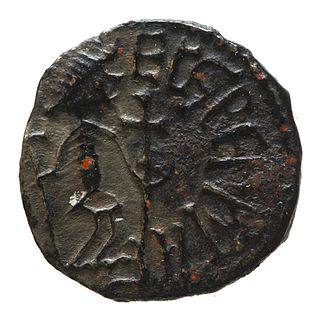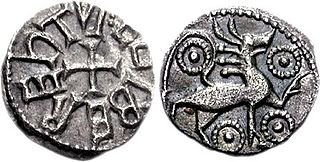Related Research Articles
Wilfrid was an English bishop and saint. Born a Northumbrian noble, he entered religious life as a teenager and studied at Lindisfarne, at Canterbury, in Francia, and at Rome; he returned to Northumbria in about 660, and became the abbot of a newly founded monastery at Ripon. In 664 Wilfrid acted as spokesman for the Roman position at the Synod of Whitby, and became famous for his speech advocating that the Roman method for calculating the date of Easter should be adopted. His success prompted the king's son, Alhfrith, to appoint him Bishop of Northumbria. Wilfrid chose to be consecrated in Gaul because of the lack of what he considered to be validly consecrated bishops in England at that time. During Wilfrid's absence Alhfrith seems to have led an unsuccessful revolt against his father, Oswiu, leaving a question mark over Wilfrid's appointment as bishop. Before Wilfrid's return Oswiu had appointed Ceadda in his place, resulting in Wilfrid's retirement to Ripon for a few years following his arrival back in Northumbria.

Stephen of Ripon was the author of the eighth-century hagiographic text Vita Sancti Wilfrithi. Other names once traditionally attributed to him are Eddius Stephanus or Æddi Stephanus, but these names are no longer preferred or accepted by historians today; modern usage tends to favour "Stephen".
Ecgberht I was a King of Kent (664-673), succeeding his father Eorcenberht.

Aldfrith was king of Northumbria from 685 until his death. He is described by early writers such as Bede, Alcuin and Stephen of Ripon as a man of great learning. Some of his works and some letters written to him survive. His reign was relatively peaceful, marred only by disputes with Bishop Wilfrid, a major figure in the early Northumbrian church.
Æthelbert was an eighth-century scholar, teacher, and Archbishop of York. Related to his predecessor at York, he became a monk at an early age and was in charge of the cathedral's library and school before becoming archbishop. He taught a number of missionaries and scholars, including Alcuin, at the school. While archbishop Æthelbert rebuilt the cathedral and sent missionaries to the Continent. Æthelbert retired before his death, and during his retirement built another church in York.

Ecgbert was an 8th-century cleric who established the archdiocese of York in 735. In 737, Ecgbert's brother became king of Northumbria and the two siblings worked together on ecclesiastical issues. Ecgbert was a correspondent of Bede and Boniface and the author of a legal code for his clergy. Other works have been ascribed to him, although the attribution is doubted by modern scholars.
Berhtwald was the ninth Archbishop of Canterbury in England. Documentary evidence names Berhtwald as abbot at Reculver before his election as archbishop. Berhtwald begins the first continuous series of native-born Archbishops of Canterbury, although there had been previous Anglo-Saxon archbishops, they had not succeeded each other until Berhtwald's reign.

Saint Cuthburh or Cuthburg, Cuthburga was the first Abbess of Wimborne Minster. She was the sister of Ine, King of Wessex and was married to the Northumbrian king Aldfrith.
Trumbert was a monk of Jarrow, a disciple of Chad and later Bishop of Hexham.

Eadberht was king of Northumbria from 737 or 738 to 758. He was the brother of Ecgbert, Archbishop of York. His reign is seen as a return to the imperial ambitions of seventh-century Northumbria and may represent a period of economic prosperity. He faced internal opposition from rival dynasties and at least two actual or potential rivals were killed during his reign. In 758 he abdicated in favour of his son Oswulf and became a monk at York.
Bosa was an Anglo-Saxon Bishop of York during the 7th and early 8th centuries. He was educated at Whitby Abbey, where he became a monk. Following Wilfrid's removal from York in 678 the diocese was divided into three, leaving a greatly reduced see of York, to which Bosa was appointed bishop. He was himself removed in 687 and replaced by Wilfrid, but in 691 Wilfrid was once more ejected and Bosa returned to the see. He died in about 705, and subsequently appears as a saint in an 8th-century liturgical calendar.
Alhfrith or Ealhfrith was King of Deira under his father Oswiu, King of Bernicia, from 655 until sometime after 664. Appointed by Oswiu as a subordinate ruler, Alhfrith apparently clashed with his father over religious policy, which came to a head at the Synod of Whitby in 664. After this, Alhfrith disappears from the historical record.
Saint Ceolwulf was King of Northumbria from 729 until 737, except for a short period in 731 or 732 when he was deposed and quickly restored to power. Ceolwulf abdicated and entered the monastery at Lindisfarne. He was the "most glorious king" to whom Bede dedicated his Historia ecclesiastica gentis Anglorum.
Eardwulf was king of Northumbria from 796 to 806, when he was deposed and went into exile. He may have had a second reign from 808 until perhaps 811 or 830. Northumbria in the last years of the eighth century was the scene of dynastic strife between several noble families: in 790, king Æthelred I attempted to have Eardwulf assassinated. Eardwulf's survival may have been viewed as a sign of divine favour. A group of nobles conspired to assassinate Æthelred in April 796 and he was succeeded by Osbald: Osbald's reign lasted only twenty-seven days before he was deposed and Eardwulf became king on 14 May 796.
Beornhæth was an Anglo-Saxon nobleman in Northumbria in the reign of King Ecgfrith. He was the first of his family to come to notice.

Eadhæd was a medieval Bishop of Lindsey and sole Bishop of Ripon in the Medieval era.

Agilbert was the second bishop of the West Saxon kingdom and later Bishop of Paris. He is venerated as a saint within the Catholic Church, with his feast day falling on 11 October.
Gilling Abbey was a medieval Anglo-Saxon monastery established in Yorkshire, England.
The Council of Austerfield was an ecclesiastical synod held at Austerfield, in southern Northumbria in 702 or 703.

The Hexham hoard is a 9th-century hoard of eight thousand copper-alloy coins of the Anglo-Saxon Kingdom of Northumbria, which were discovered whilst a grave was being dug close to Hexham Abbey in 1832.
References
- ↑ https://www.encyclopedia.com/arts/culture-magazines/kirby-david-peter
- ↑ Brill, Reginald (1969). "The Making of Early England. By D. P. Kirby. (New York: Schocken Books. 1968. Pp. 320. $9.00.)". The American Historical Review. doi:10.1086/ahr/75.1.92-a. ISSN 1937-5239.
- ↑ Tipton, Charles L. (1969). "Review of The Making of Early England". The Historian. 31 (3): 460–461. ISSN 0018-2370. JSTOR 24440579.
- ↑ Taylor, H. M. (1976). "Saint Wilfrid at Hexham. Edited by D. P. Kirby. 9½ × 6¼. Pp. xi + 196 + 29 pls. Newcastle upon Tyne: Oriel Press, 1974. £5.50". The Antiquaries Journal. 56 (1): 106. doi:10.1017/S0003581500019909. ISSN 1758-5309. S2CID 162325717.
- ↑ Mayr-Harting, H. (1977). "Review of Saint Wilfrid at Hexham". The English Historical Review. 92 (362): 182–183. doi:10.1093/ehr/XCII.CCCLXII.182. ISSN 0013-8266. JSTOR 566330.
- ↑ Rosenthal, Joel T. (1992). "D. P. Kirby. The Earliest English Kings. London: Unwin Hyman; distributed by Harper Collins Academic, Scranton, Pa. 1991. Pp. xv, 241. $17.95 paper". Albion. 24 (1): 89–90. doi:10.2307/4051244. ISSN 0095-1390. JSTOR 4051244.
- ↑ Rollason, David (1994-06-01). "Kings and Kingdoms of Early Anglo-Saxon England". The English Historical Review. 109 (432): 680–682.
- ↑ James, Maureen (2013). "Marvels, Magic and Witchcraft in the North Riding of Yorkshire: David Naitby's Bedale Treasury". Folklore. 124 (1): 110–111. doi:10.1080/0015587X.2013.737511. ISSN 0015-587X. S2CID 161918619.
- ↑ Mead, Harry (2010-01-08). "A rich and poetic contribution to a town's Georgian heritage". Darlington and Stockton Times. Retrieved 2024-01-20.